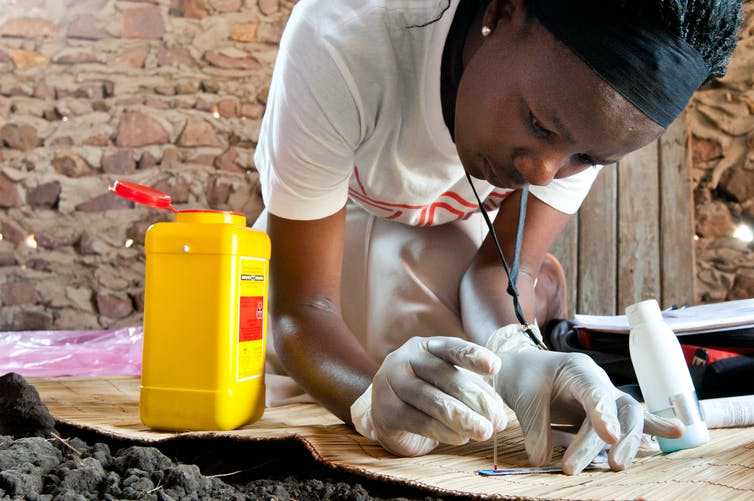
[COVID-19 death toll per Nov 17. 2020; 1,3 mill.]
Peter Casaer
Gilles van Cutsem, University of Cape Town
Twenty years ago treatment for HIV was a rare luxury in South Africa. Exorbitant costs and President Thabo Mbeki’s government’s fierce opposition to providing antiretroviral treatment (ART) kept it out of the public sector.
They were terrible days. Many lives were lost.
The environment has changed remarkably since then. The turning point came in 2004 when, after four years of struggle, led by the Treatment Action Campaign, the government begrudgingly agreed to start providing ART.
Antiretroviral coverage of people with HIV in South Africa has increased from 0% in 2000 to 71% in 2019. The South African antiretroviral program is now the largest in the world, with more than five million people on treatment, and increasing. HIV-linked deaths decreased from 150,000 in 2000 – peaking at around 300,000 in 2006 – to 72,000 in 2019.
But deaths have not decreased as much as was hoped. HIV remains a leading cause of death in South Africa. Many people still present to health facilities with advanced HIV disease. And AIDS remains a major contributor to hospitalisations and deaths in Africa.
Read more:
South Africa’s remarkable journey out of the dark decade of AIDS denialism
Globally, 690,000 people died from HIV in 2019.
Doctors Without Borders (MSF) supports hospitals in South Africa, Guinea, the Democratic Republic of Congo (DRC), Malawi, and the Central African Republic that continue to treat large numbers of people with AIDS. Because people present with very advanced HIV disease, up to one in three dies during their hospital stay.
One of the main challenges remains that diagnostics and drugs aren’t readily available for people suffering from advanced HIV. This group of people is very vulnerable to deadly opportunistic infections such as tuberculosis (TB), meningitis, and severe bacterial infections.
This all goes to show the world is very far from the end of AIDS.
Gaps
In the last ten years, the focus has been on diagnosing people with HIV and starting them on treatment. Efforts around the test-and-treat approach have been mobilised around the UNAIDS 90-90-90 targets: 90% of people with HIV to know their status; 90% of those whose status is known to be on antiretroviral therapy; and 90% of those on antiretrovirals to have an undetectable viral load.
This is necessary but it is not enough to address HIV-related mortality. Life-long treatment requires life-long support. Some people will interrupt treatment; some will struggle to take their tablets every day, risking developing drug resistance and treatment failure.
Today, most people with advanced HIV either are failing or have interrupted treatment. In two MSF-supported studies in the DRC and Kenya, only 20%-35% of inpatients with advanced HIV were ART-naïve (had never accessed treatment) and over half of those on ART had treatment failure.
The reality of treatment interruption and treatment failure requires a new approach.
This is why MSF piloted Welcome Back Services in Khayelitsha, Cape Town. The services focus on the needs of patients returning to care and those failing treatment. Stigmatisation and blaming patients for interrupting or failing treatment is common. This leads to delays in seeking care, and patients presenting as false-naïve – patients retesting for HIV and hiding the fact that they were previously on treatment.
This in turn leads to patients presenting in more advanced stages of the disease or on inadequate treatment.
This is one of the reasons why HIV still claims too many lives. Patients who present very late often have severe immune suppression, multiple concurrent life-threatening illnesses, and significant organ damage due to HIV itself. Treatment is complicated by the need for many different medicines, with a higher risk of drug interactions and severe side effects. Even with intensive care, unavailable in most settings, many patients die.
TB is the leading cause of death among people with HIV in resource-limited settings. It is estimated that TB is responsible for around 50% of deaths. Two other leading causes are cryptococcal meningitis, which is responsible for one in five HIV deaths, and severe bacterial infections.
Together, these infectious diseases cause more than two-thirds of HIV-related deaths. All three are preventable and treatable – if detected early enough.
No time to lose
There are immediate steps that can be taken.
There are more options than ever to prevent TB disease. New evidence shows that shorter regimens of rifapentine and isoniazid, weekly for three months or daily for one month, are equally effective at treating latent TB and decreasing deaths compared to the older regimen of isoniazid for six to 36 months. And a recent trial demonstrated that a four-month treatment with a new regimen was as efficacious as the current six-month regimen to treat active TB disease.
When left untreated, the odds of surviving cryptococcal meningitis are zero. But cryptococcal meningitis can be prevented and there have been advances in treatment. Daily fluconazole is recommended in some countries for the prevention of a first episode, and everywhere as secondary prophylaxis to prevent recurrent disease. Treatment with flucytosine and amphotericin B reduces mortality by 40%. Yet these medicines are still missing in many – if not most – health structures in Africa.
Steps can be taken to prevent death from advanced HIV. These include earlier detection at the primary care level – before patients develop disease so severe that they seek hospital admission. The longer the delay to diagnosis and treatment, the lower the chances of survival.
This is where CD4 tests and rapid tests for TB and cryptococcal meningitis are life-saving.
What is needed urgently to save lives is accelerated access to a package of care for the prevention, diagnosis, and treatment of advanced HIV at the primary care and hospital level, along with strategies with clear targets to decrease AIDS mortality.![]()
Gilles van Cutsem, Honorary Research Associate, Centre for Infectious Disease Epidemiology and Research, University of Cape Town
This article is republished from The Conversation under a Creative Commons license. Read the original article.




22 Comments
Pingback: meditation music
Pingback: ทางเข้า เอเอ็มบี ล็อตโต้ มีหวยอะไรบ้าง ?
Pingback: เกมบาคาร่าเล่นกับค่ายไหนดี ค่ายไหนที่ได้รับความนิยมมากที่สุด
Pingback: bonanza178
Pingback: จำนำนาฬิกาหรู
Pingback: ฟันคัพ
Pingback: porcini mushrooms buy
Pingback: dee88
Pingback: https://mytrip123.com/wp-content/uploads/2023/01/8737.html
Pingback: fuckboy
Pingback: https://stealthex.io
Pingback: ซื้อทราย หาดใหญ่
Pingback: xo666
Pingback: faw99
Pingback: online videos
Pingback: som777
Pingback: pgslot168
Pingback: คลินิกเสริมความงาม
Pingback: รับออกแบบลายเซ็น
Pingback: BAU_2025
Pingback: เครื่องทําสเลอปี้
Pingback: ลงทุนแฟรนไชส์